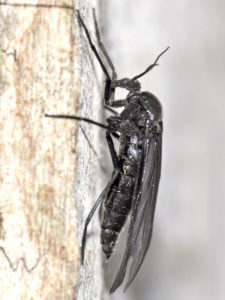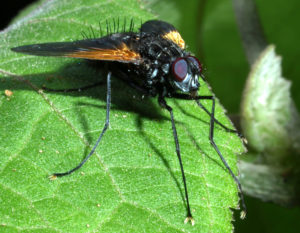
giant sciarid fly
From a 4 hectare (about 9 acre) patch of cloud forest near San José, Costa Rica, a team of dipterists (fly researchers) have identified over 4000 species of flies, and extrapolations from this collecting suggest that the true total is 7,000 – 8,000. This incredible diversity was the result of the ZADBI project, funded by the US National Science Foundation. A team of talented and dedicated Costa Rican biologists sampled at the site, called Zurquí de Moravia, for an entire year, using several Malaise traps, regular light trapping, hand collecting and other methods. The resulting catch was prepared (mounted, pinned, slide-mounted, labeled) and sent to international experts on various fly families for identification. The result was an eye-popping number of species, many of them new to science (especially in the families of smaller flies).
Leading the way were the gall midges, or Cecidomyiidae, which were represented by at least 800 species, almost all of the probably undescribed. During the course of the project, cecid expert Dr. Mathias Jaschhof actually described some of the new species, including those that belonged in a new genus he named Zadbimyia in honor of the project (there were 19 of the 22 species of this genus alone at Zurquí).
Second most species rich were the phorids, whose numbers were so large that I am still reeling from the effort of trying to understand their diversity (with help from Maria Wong, Giar-Ann Kung, John Hash, and others). The 400 species we identified is surely just part of what is really there.
There were hundreds of species of other families of flies as well, including lots of strange and wonderful new things. It will be years before we can finish identifying everything, but the project gives us some important insights into tropical Diptera diversity. It is also a testament to how effective a large group of dipterists can be, identifying thousands of specimens of one of the least-known biotas in the world.
I hope to bring you many more details about the results from the project, but for now, here are links to the two recently published papers:

tachinid fly, photo by W. Porras







 In the recent “City Nature Challenge” (an iNaturalist event co-hosted by our museum, LACM), the question was indirectly asked of me “how do you separate the common greenbottle flies, classified in the calliphorid genus Lucilia, from the muscid lookalikes in the genus Neomyia that can also be green.” Especially, how would you tell them apart from the photos in iNaturalist, which are often not of stellar quality. My answer is to look them in the face. In both genera, the distribution of tomentum (microscopic extensions of the fly’s cuticle; not ‘hairs’ or setae, which are socketed) is different. The tomentose parts of the frons reflect light as silver or white, so this is often easy to see in photos.
In the recent “City Nature Challenge” (an iNaturalist event co-hosted by our museum, LACM), the question was indirectly asked of me “how do you separate the common greenbottle flies, classified in the calliphorid genus Lucilia, from the muscid lookalikes in the genus Neomyia that can also be green.” Especially, how would you tell them apart from the photos in iNaturalist, which are often not of stellar quality. My answer is to look them in the face. In both genera, the distribution of tomentum (microscopic extensions of the fly’s cuticle; not ‘hairs’ or setae, which are socketed) is different. The tomentose parts of the frons reflect light as silver or white, so this is often easy to see in photos.